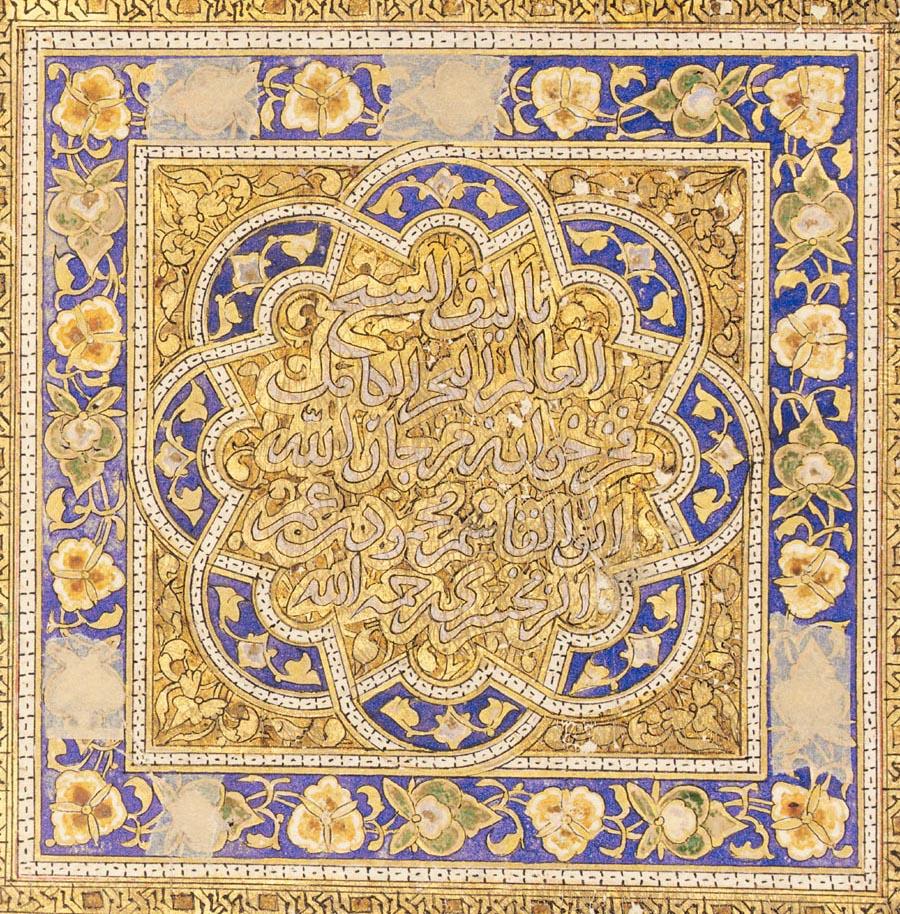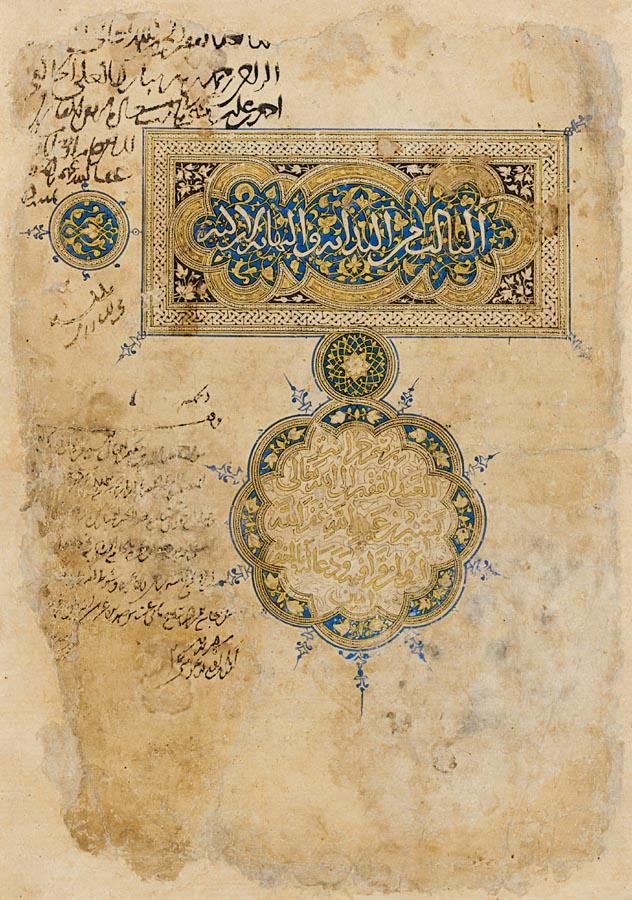

An Egyptian frontispiece for a manuscript, in naskh, 1340
Source: http://search.sothebys.com/jsps/live/lot/LotDetail.jsp?lot_id=4DV8J
(downloaded Mar. 2005)
"AL-ZAMAKHSHARI, ABU'L QASIM. AL-KASHIF 'AN HAQQA'IQ AL-TANZIL, ARABIC MANUSCRIPT ON PAPER, COPIED BY 'ABDUL MU'MIN BIN MUHAMMAD BIN AL-SABBAK, MAMLUK, EGYPT, DATED A.H. 741/A.D.1340. Measurements note: 26 by 28cm.
DESCRIPTION: 248 leaves, 23 lines of neat naskhi script in black ink, grammatical points picked out in red, first folio with intricately worked panel in colours and gold, title in gold thuluth within an ornate cartouche against black ground with scrolling foliate motif in white, beneath that a square panel with a scalloped cartouche bearing a 12 pointed medallion with author's name in white thuluth reserved on gold, later brown morocco binding
CATALOGUE NOTE: The exquisitely rendered frontispiece of this lot is closely comparable to the following lot in this sale, where the heading is in reserve against a black ground with a scrolling vegetal motif in white, as it is here. The two lots are also related in the superb scalloped cartouche holding a twelve pointed medallion bearing an inscription in thuluth, parallels can be drawn even in the detailing of this feature; with the ornament in the interstices of opposing florets illuminated in relief against a lapis ground.
The author Abu'l-Qasim Mahmoud ibn 'Umar al-Zamakhshari (d.538/1144) is described as one of the foremost scholars of the late medieval period, and one of the last great Mu'tazila. His interests ranged from the linguistic sciences, such as grammar and lexicography, to theology and the Qur'anic exegesis - the topic of the present lot. Born and raised at Zamakhshar in Khawarzam he was however a strong advocate of the Arab cause and travelled widely in the Islamic territories, visiting Mecca at least twice in his lifetime. The basis for his staunch support of the Arabian versus the Persian traditions was his firm belief in the divinity and importance of the Arabic language. His opinions were based on the fact that Arabic was the language of the revelation and the empire's administration, and that "its grammar is the source for all the sciences whose issues ultimately depend on the comprehension of the Arabic language and its grammar." (EI 2002).
Abu'l Qasim al-Zamakhshari wrote several works on grammar and lexicography, including a bilingual Persian-Arabic dictionary and an Arabic thesaurus. However his most widely acclaimed work is the present example, which made him famous throughout the Islamic world. The Kashif 'an Haqqa'iq al-Tanzil attempts to explain the Qur'an's grammar, rhetoric and lexicography as well as its varied readings and "miraculous nature"(EI, S, xii; p.840)."

A similar frontispiece, but a bit later.
Source: http://search.sothebys.com/jsps/live/lot/LotDetail.jsp?lot_id=4DV8K
(downloaded Mar. 2005)
" ILLUMINATED TITLE PAGE FROM AN HISTORICAL TEXT BY IMAD AL-DIN ISMA'IL IBN 'UMAR IBN KATHIR, MAMLUK, EGYPT, SECOND HALF 14TH CENTURY. Measurements note: 31.2 by 21.6cm.
DESCRIPTION: leaf of buff brown paper with illumination in gold blue and black, intricate rectangular headpiece bearing volume's title as "The Third Chapter of the Beginning and End" in white thuluth within an ornately worked scalloped cartouche with circular medallion extending into the margin, scalloped shamsa framing a 16 point lobed medallion bearing the patron's name as "Bashir b. 'Abd Allah", a waqf inscription in black ink in margin reading "Ordered for the library of the poor slave of God the highest: Bashir b. 'Abd Allah."
CATALOGUE NOTE: The decorative features of this leaf relate it to Mamluk Qur'an illumination of the second half of the fourteenth century (James 1988, fig.132, p.190). Although many of the features exhibited in the present example are closely comparable to the frontispiece of lot ten in this sale, that is dated to A.H. 741/AD.1340, certain historical references determine that this frontispiece cannot have been completed prior to 1366. A comparison of these two pieces provides an intriguing insight into the development of the "Star Polygon" group. A group that is closer, historically speaking, to the present example although it shares many of the decorative features of lot ten, and from which a number of superlative imperial manuscripts were produced (for a further discussion of the "Star Polygon" group see James 1988, pp.180-197, fig. 127-137).
The author of the present lot 'Imad al-Din Isma'il b. 'Umar b. Kathir, was born in Basra in around A.H. 700/A.D. 1300 and died in Damascus in Sha'ban 774/February 1373; he was a known chronicler and historian of the Mamluk period and his works provide a wealth of information on Mamluk society and traditions."